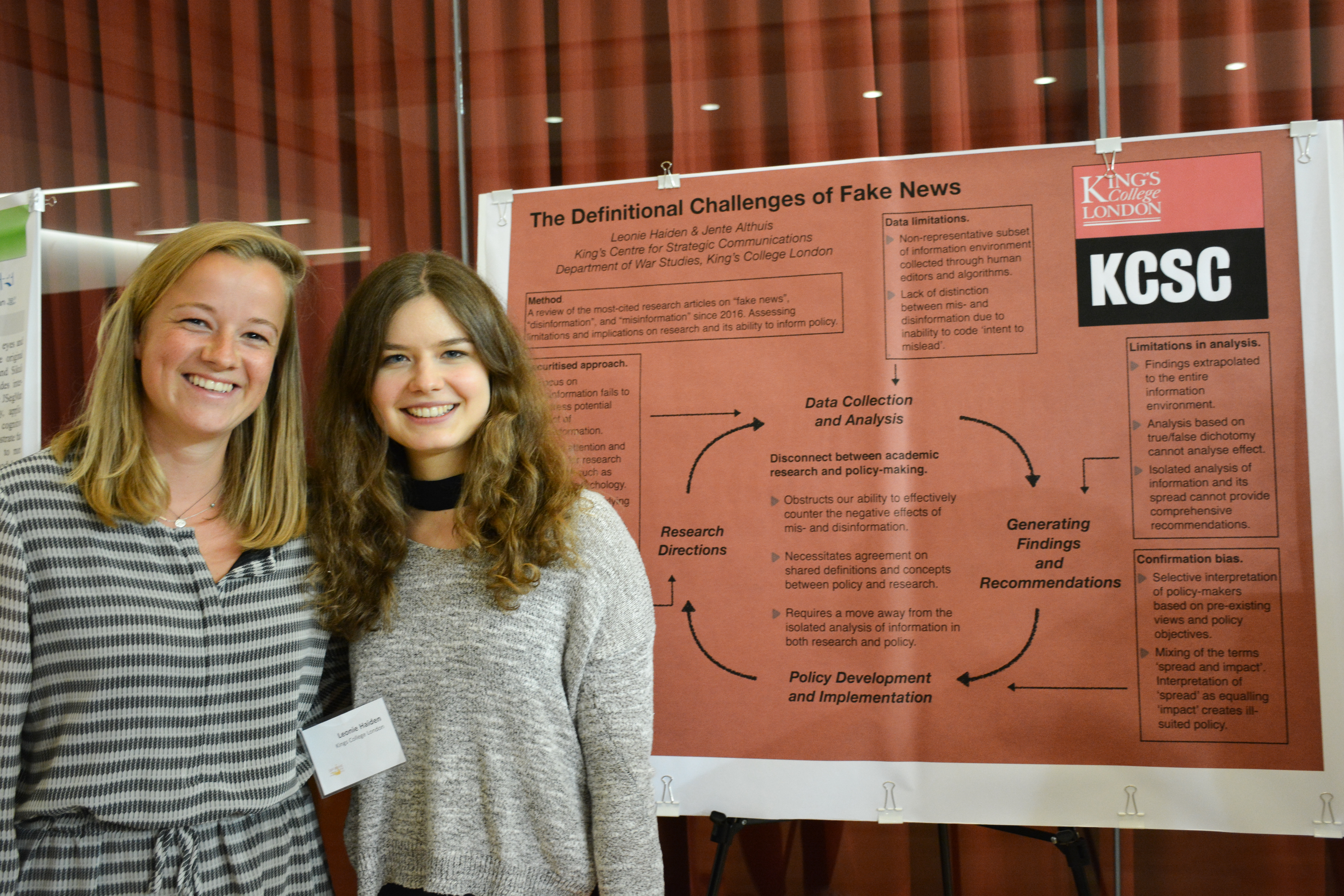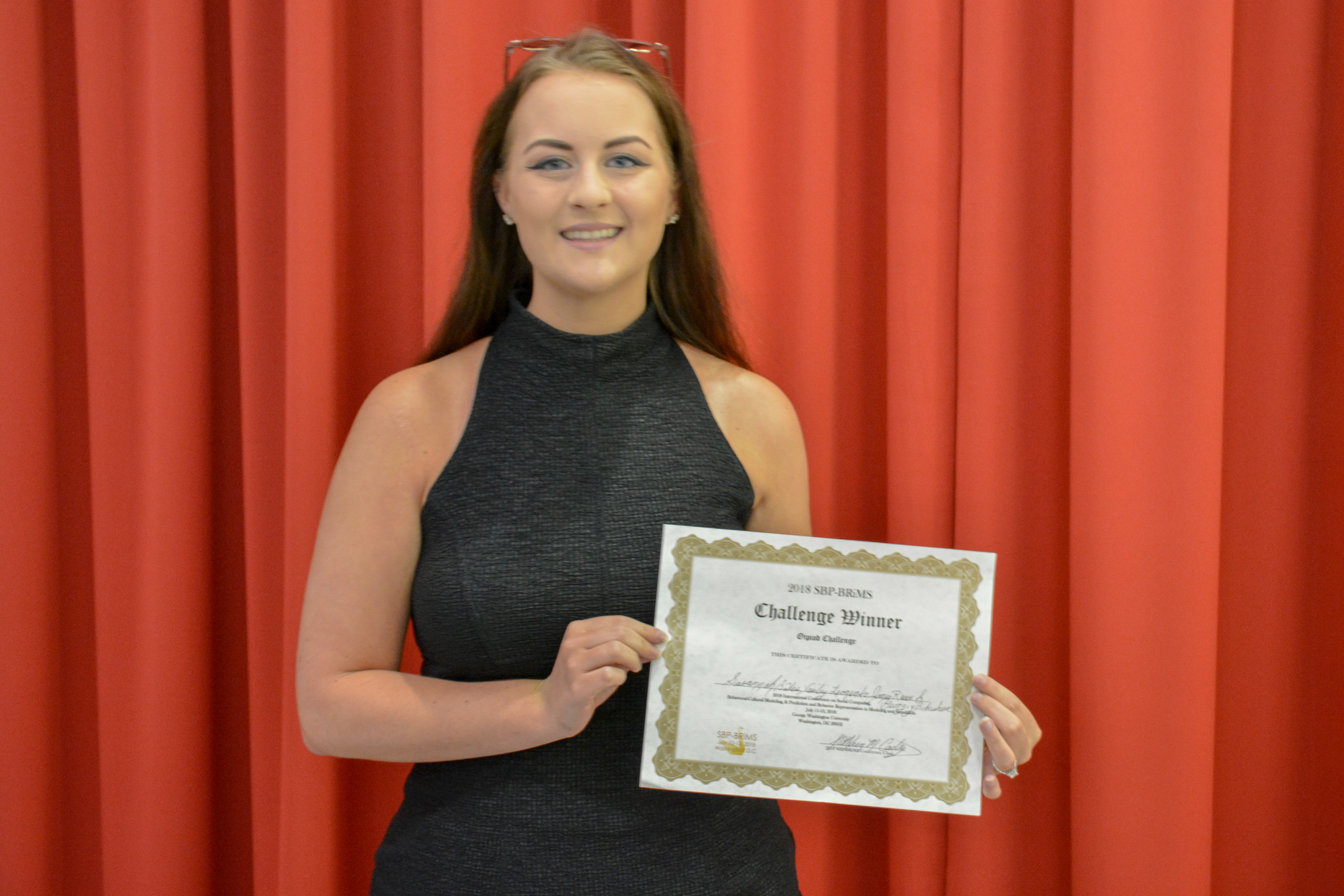SBP-BRiMS 2018 Grand Interdisciplinary Data-Science and Modeling Challenge.
George Washington University,Washington DC, USA
(part of the SBP-BRiMS 2018 conference - July 10 – July 13, 2018)
More information on Challenge 1 Opiods.
More information on Challenge 2 Disinformation.
More information on Challenge - Videos 2018.
Guidelines
A strong entry generally has one or more of these components:
- Employ multiple data sets.
- Be theory based.
- Include at least one high quality visualization (note that participants will be allowed to display dynamic visualizations via some form of electronic media e.g., by hanging a tablet from the poster. However, please note that tables will not be provided.
- Account for biases in the data across time, space, topics and sources.
- Demonstrates a deep understanding of the problem being addressed.
- Providea a new metric, simulation or algorithm development such as:
- A new spatial, temporal, or network analytic methodology or algorithm, or a simulation model, that can cope with the vast scale of open source data (e.g.Twitter data) and support answering a key social or policy issue.
- A new spatial analytic methodology that can better take into account change over time and non-spatial distances (such as co-occurrences and semantic similarity between locations).
- A new network methodology that better incorporate the diversity of actor and relationship types in the data, spatio-temporal information, or for constructing edges from the data and for distributing actor and edge attributes onto the graph.
- A novel simulation that that supports reasoning about the spread of fake news or propaganda that uses empirical data to either instantiate the model or to confirm some of the results.
- Generates a new empirical finding that challenges or provides novel support for existing social or political theory, or provides information of policy relevance. Note, the results of computer simulation are viewed as empirical findings.
In addition, a strong entry should be well-written and provide some level of creativity in its use of or combination of data.
Submitting and Entry
What to Submit
You need to submit 3 things - An extended abstract, A PDF of your poster, and A powerpoint promotion slide. All three of these will go in the on-line proceedings
Extended Abstract: A 2-page abstract describing the project. This should define:
- What social/policy question was asked or challenge addressed?
- Why is this question important or the challenge critical in the context of fake news and/or propaganda?
- What data sets were used?
- What is the novel contribution?
- What is the key methodology or methodologies used?
- What is the key policy issue or theory being addressed?
- Who is the team? Provide names, email and institution.
A PDF of your poster: This will be put on line.
You are, however, responsible for printing and bringing your own poster to the conference. An easel will be provided, but not posterboard.
The poster should be either 4’x3’ or 3’x4’.
Promotion Slide
This is a single powerpoint slide. The purpose of this slide is to excite people to come to your poster. This slide will also be put on line. You will be given one minute to present this slide at the conference to encourage people to come and see your poster. This slide should contain:
- Title of project
- Names of all team members
- Any word or image or idea that you think will promote your poster
- Logos for your group, company or organization
When to Submit
Challenge Response Submission: 14-May-2018
At this point just send the short abstract.
Author Notification: 01-June-2018
Final Version Challenge Response Submission: 25-June 2018
At this point send the paper, the slide, and a PDF of the poster.
How to Submit
All challenge participants will need to submit these items:
- Short Abstract: Due May 14th, This is a maximum of 6 pages including references and figures. It should address what was done, how it was done, what data was used, and how this met the challenge.
- One page slide: This is a synopsis slide that will be used in the 1 minute teaser presentation to get people to come to the poster.
- PDF of the poster that can be viewed online.
- Final Challenge paper: Due June 25th, This is a maximum of 10 pages including references and figures. These should not have been submitted elsewhere. These will be put on the conference website as part of the online proceedings which is not archival. In addition, the final paper of the winner, runner up, and potentially other final papers, will be published in a special issue of the journal of Computational and Mathematical Organization Theory which is archival. Submission of a challenge entry constitutes willingness to have the final challenge paper published in the venue.
- Who is the team? Provide names, email and institution.
- The abstract, slide, and poster that are student-led need to be clearly marked as student-led. To be considered student-led the following conditions must be met:
- The project was led by a student enrolled in a university
- The project is not coming out of a corporation, government lab, or FFRDC
What to Present
All entries will send at least one team member to SBP-BRiMS 2018 who will be registered for the conference
by the early registration deadline to present their poster in the evening poster session on Wednesday. The poster will be 4’x3’ or 3’x4’. Participants may bring in additional props to enhance their presentation.
On Wednesday at the end of the plenary session before lunch, the team spokesperson should be ready to present a 1 minute talk using the slide, to encourage people to come to their poster.
On Wednesday, each team will also do a short talk that will be video taped and made available describing their approach and solution. This vedo talk should be no more than 12 minutes.
Finally, the winning entry will give a short talk on the last day of the conference. This will be a 12 minute talk with 3 minutes for questions.
How entries will be judged
Entries will be judged by community voting at the poster session.
Who is eligible
Anyone with an interest in using this data to address a social or policy issue. Entries are accepted from single individuals or teams.
Suggestion: Participants may want to use Jupyter to demonstrate their code and results. Examples can be found here, Sample Jupyter Notebooks.
Winning Entry
The final paper for the winning entry, for each of the two challenges, will be published in the journal Computational and Mathematical Organization Theory – in the SBP-BRiMS 2018 special issue.
A member of the team that developed the winning entry will do a short presentation on either thursday or friday at the conference describing the response.
Challenge Committee
- Kathleen M. Carley
- Ayaz Hyder
Submit Questions Regarding Challenge
All questions and concerns can be sent to sbp-brims@andrew.cmu.edu
The submission website is available at: https://easychair.org/conferences/?conf=sbpbrims2018. Be sure to choose the Challenge track.


